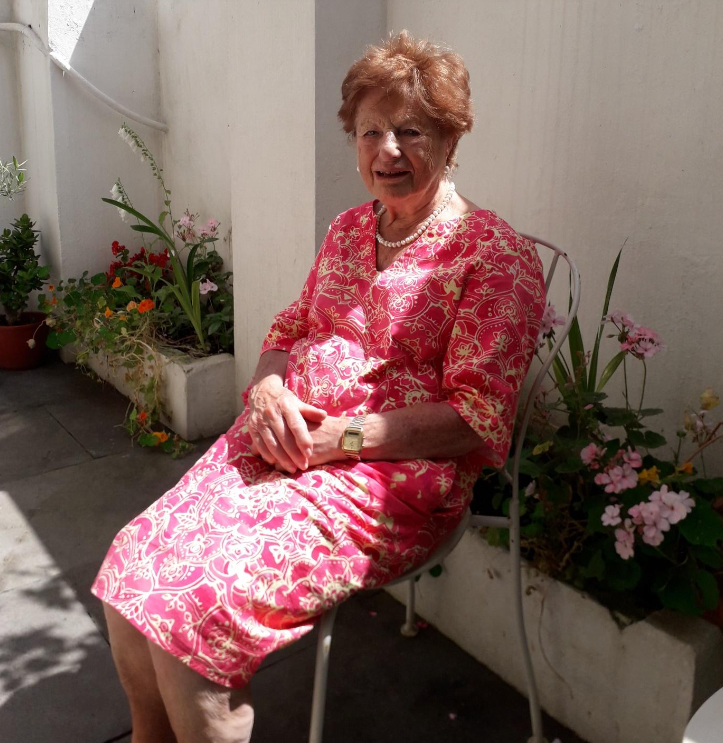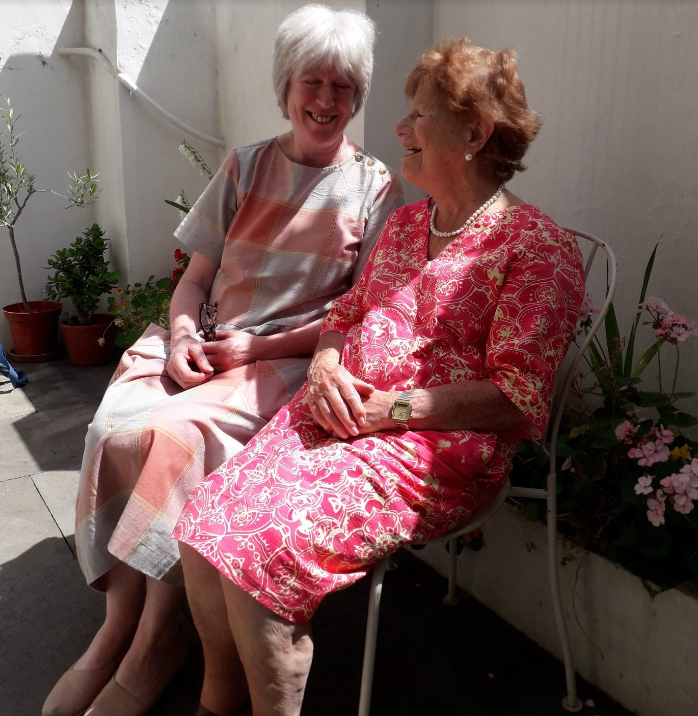
This is the story of a journey. It starts with a little girl of six growing up in a non-practising Jewish family. She was curious about Jesus Christ. She had heard school friends talking about him after their RE classes which the Jewish girls did not attend. Who was he? she wondered. Today her journey has reached the DHEF centre, Pembridge House.
Hilary Schlesinger was born in 1929, one of five talented and creative children. Her grandparents had emigrated from Germany at the end of the 19th century. Her father was a distinguished physician and during the 1930s he set up a fund through which he and his wife cared for 13 refugee children from Germany, one of whom lived as an extra sibling with the five Schlesinger children. But God was not part of the Schlesinger family’s world.
When the war broke out Hilary was sent to Badminton School in Bristol. “The headmistress was a Quaker communist,” recalls Hilary. “It was a very forward-looking school and we were taught to be open-minded about all cultures and religions. On Sundays, I used to sign up to go to a different church each week out of curiosity.”
Hilary played the violin very well. After she left school she went to music college and gained a performer’s diploma. “It was always assumed I would be a professional musician,” she says. “I played in orchestras and in a string quartet. But I felt there was something lacking in studying and playing the violin. I was also very interested in people and performing kept people at a distance.”
A friend from school had trained as an occupational therapist. This appealed greatly to Hilary, who was driven towards helping people. Before making the break with music, however, Hilary took a job playing the incidental music for a play running at the Cambridge Theatre, London. This was “Maria Marten and the Red Barn”; the story of a notorious Victorian murder. Her fellow musician in the orchestra pit was Donald Swann, of the famous duo Flanders and Swann.
By now Hilary was clear she wanted to change profession. “At that time I believed in fate, not God,” she says. “Although I can see now that God was at work, and in some ways I was starting to search for Christianity then, although my ideas were very romantic and idealistic.”This idealism drew her to the Pestalozzi Children’s Village in Switzerland which cared for children affected by war. Hilary offered her services as a teacher of violin and English language. But she was turned down as only couples were accepted. This rejection was the impetus for Hilary to head to Oxford to start training as an occupational therapist.
Once in Oxford God began to encroach into Hilary’s life. “There was one therapist in the hospital who was different,” remembers Hilary. “I realised that she was a practising Christian. One morning we were preparing the department for patients who were very seriously ill with polio. It was 9am and I suddenly said to Janet: ‘How do I become a Christian?’ I can see her now, her finger on her bottom lip, thinking how best to answer such a question at such a busy moment. Her reply to me was: ‘Read the bible’. So I bought a bible and started to read it.”
While in Oxford Hilary was living in a house with a history don who was married to the granddaughter of H G Wells; the celebrated author was emphatically not a Christian, so there was no vestige of Christianity in that kind and supportive household to encourage Hilary.
However, Christianity began to take root in Hilary. “I had never prayed before. But each night I knelt and asked; ‘Show me the truth.’ Although I kept all this secret. ”Another episode at this time made an impact on Hilary. While working in the hospital in Oxford she was asked to nurse the American poet Joy Davidman, who was married to C.S. Lewis of Narnia fame. At the time Joy had converted to Christianity, and knew she had terminal cancer. “I was terrified of death then,” says Hilary. “I saw death as a dark abyss. I felt I couldn’t face a woman who knew she was going to die. But I had to do it and so I went into her room. And there she was, with C.S. Lewis, standing up with her crutches, a huge smile on her face, so proud that she had managed to walk a few steps. It was exactly as portrayed in the film ‘Shadowlands’. I thought to myself; there is something here. This must be Christianity.”
Hilary’s journey towards Christianity now began to gather speed. From Oxford, she went to Switzerland to do post graduate training. “I wanted adventure!” she says. It was there that she encountered three American Evangelical Christians who were setting up occupational therapy as a discipline in that country. “I was impressed by these people, “says Hilary. “But very embarrassed when they started prayer meetings before starting work “.
While in Switzerland Hilary met the famous American Evangelical theologian, Francis Schaeffer. Listening to the discussion and debate at Schaeffer’s mountain chalet, “I was bursting to become a Christian”, Hilary remembers.
“Then one day, Schaeffer’s wife, Edith, took me to one side, asked me if I accepted the basic tenets of Christianity and if I would like to become a Christian now.” Hilary said yes. “So there I was,” says Hilary, “A tiny, little baby flea of a Christian. In the power of something bigger.”
Hilary’s next port of call was South America. An epidemic of polio in Argentina in 1956 meant that there was an urgent need to help polio victims. She joined a British team to set up the first school of occupational therapy in Argentina in 1959. This was ground-breaking, with graduates from the school subsequently going out to other countries in South America. “I was there for five years,” she recalls. “It was tough. I had to learn Spanish on the job.”
By now an expert in her field, Hilary was approached by the International Labour Organisation (ILO) to go to Chile to start employment rehabilitation there.
It was here she met Carlos Mario Londoño, a Colombian who also worked for the ILO. Little by little, lending her books and making gentle suggestions, Carlos Mario led Hilary nearer to the Catholic faith. Unknown to Hilary, Carlos Mario was a supernumerary member of Opus Dei. And then one day he introduced her to a friend - this lady was a numerary, Tere Sumalde. “And she was great fun,” says Hilary.
Then came another pivotal moment in Hilary’s life. A priest of Opus Dei phoned her, announcing that Carlos Mario had told him that she wanted to know more about Roman Catholicism. “What cheek!” was Hilary’s first thought, but really she was delighted.
This encounter ended happily. On 19 March 1968, Hilary was baptised in a centre of Opus Dei in Santiago de Chile. “I was wearing a beautiful dress of champagne coloured wild silk,” she recalls. The priest was nervous of splashing water on Hilary’s dress “¿Qué hago?” – What shall I do? – he said. Meanwhile, overcome with nerves, Hilary was laughing hysterically. Finally, a reassuring smile from Tere calmed everyone down. Hilary became a Catholic. And six months later asked for admission to Opus Dei as a numerary member.
Hilary’s contract in Chile ended in March 1968. Her idealism surfaced again and her first idea was to rush to Israel to help with the aftermath of the Six Day War. This was not to be.
By now at the peak of her profession, Hilary spent another five years, based in Colombia, travelling extensively in South America, setting up centres for employment rehabilitation, to equip disabled people to get into work.
Returning to Britain, Hilary worked for Lambeth Council and for Scope, the disability equality charity. She has left a remarkable legacy in both hemispheres.
This is a story about a journey towards God. A story of twists and turns, with unlikely and surprising events. In 1972 Hilary, en route to Poland, met the founder of Opus Dei, St Josemaria Escriva, in Rome. Another highlight in her life.
Today Hilary seems as full of life as ever. She has told her story, but she is full of questions about DHEF activities and plans for the future.
“Who is Jesus Christ?” asked the six-year old Hilary. She knows the answer now.
